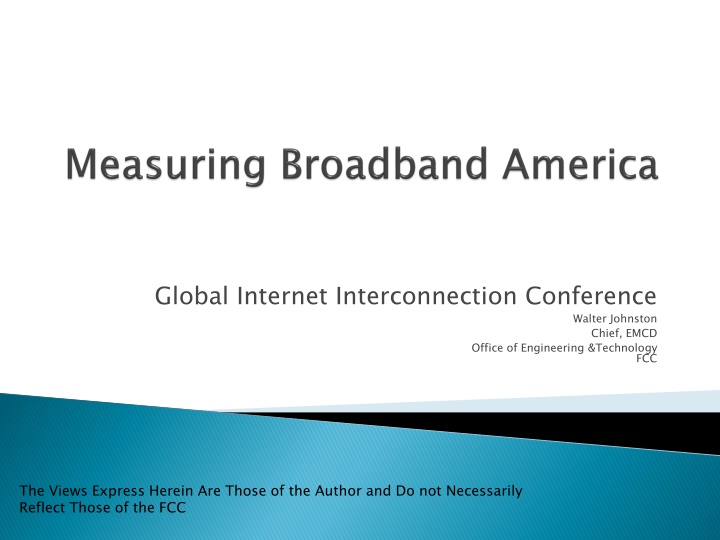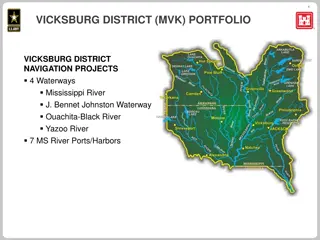
Empowering Society Through Broadband and Internet Connectivity
Discover how broadband and the Internet are empowering society with productivity gains, enhanced communication, entertainment, public safety, and connected government. Explore the initiatives taken by FCC to improve broadband performance and accessibility, including the National Broadband Plan and measuring internet performance data. Learn about the instrumented consumer homes program and the improvements in ISP services over the years. Gain insights into the impact of these efforts on internet connectivity and the FCC's role in supporting research and development in the field.
Download Presentation

Please find below an Image/Link to download the presentation.
The content on the website is provided AS IS for your information and personal use only. It may not be sold, licensed, or shared on other websites without obtaining consent from the author. If you encounter any issues during the download, it is possible that the publisher has removed the file from their server.
You are allowed to download the files provided on this website for personal or commercial use, subject to the condition that they are used lawfully. All files are the property of their respective owners.
The content on the website is provided AS IS for your information and personal use only. It may not be sold, licensed, or shared on other websites without obtaining consent from the author.
E N D
Presentation Transcript
Global Internet Interconnection Conference Walter Johnston Chief, EMCD Office of Engineering &Technology FCC The Views Express Herein Are Those of the Author and Do not Necessarily Reflect Those of the FCC
Broadband and the Internet empowering our society Productivity Gains Enhanced communications Entertainment Public Safety Connected Government Important to measure availability and quality of broadband Availability Performance Year by Year Trends Open Internet Order established transparency requirements for Broadband Internet Access Providers (BIAS)
2010 FCC issued National Broadband Plan Established goal to obtain Internet performance data to support policy development 2010 initiated program to provide most accurate data on fixed broadband to the home Cooperation of major ISPs supporting 85% of consumers 13 15 ISPs in program; remaining 3000 ISPs support 15% of population 2014 initiated coverage of mobile broadband performance Crowd sourcing approach Data collected includes performance data, cell tower/service coverage data, and phone data
Instrumented ~6000 consumer homes in U.S. Annual report Continually collect data from these homes Speeds, latency, loss Baseline data for report collected Sept/Oct annually All collected data available on website Research initiatives supported when feasible WTF Georgia Tech Latency data provided to CAIDA CGN studies, congestion studies under consideration Consumer nodes can be limiting factor Limits/Opportunities established by WTF Recently finding 100 Mb/s rates and higher rates challenging measurement platforms Hope to test 1Gb/s services this year (Beta) Interest in shaping program to better support research
Over first 3 years, ISP services improved Ration of delivered/advertised increased Spread between best/worst diminished Provided better understanding within Commission regarding functioning/operating of the Internet Supplements additional information sources Provides enduring baseline data for Commission Information integrated into other FCC programs
Started analyzing service consistency Streaming services changing landscape QOS Performance over time Video streaming performance Service characterization: Netflix, Hulu, YouTube Maximum achievable streaming capability Interconnection points Supporting research using latency to characterize congestion Hope to expand data program focused on Interconnect FCC Technological Advisory Council Recommended in 2015 expansion of program What network points to capture Where to evolve How to obtain data
Crowd sourced data collected from volunteers phones Open methodology developed with industry collaboration Clients available on GitHub as open source for inspection No PII data collected, no ads, no commercial intent We have spent two years verifying validity of data and examining how best to present
Android Released in mid-November 2013 Available at Google Play: FCC Speed Test iPhone Released February 2014 Available to public at iPhone App Store: FCC Speed Test For a very short time we were 4th most popular app in the store Android phones provide 4x data as iPhones due to automatic scheduling of tests Favorite comment Very useful app and surprisingly not ugly
Event oriented; News article or blog post last about 10 days Evolving outreach program to keep reinforcing program and apps We have been silent on this app for two years due to industry concerns However last two competitive wireless reports included MBA data Will seek to spotlight program in 2016
Extensive analysis of data with comparison to other data sets e.g. Ookla, RootMetrics At sufficient levels of aggregation Data meets statistical validity criteria All data sets in general agreement At sufficient levels of disaggregation, weaknesses in all methodologies become apparent Crowd sourcing and drive testing both dependent upon limited sample sets at high area resolutions
Huge datasets when aggregated Sparse datasets when data disaggregated Drive testing: specific locations measured twice a year Crowd sourcing: a few consumers as proxy for all Street level measurements mean what to average consumer? No average consumer at high resolution How to present data challenging problem
Mobile competitive environment is fierce Government comment on performance perceived as threatening Many service providers advertise best network Vigorous push-back from some participants Lengthy process to establish validity of data But also a recognition that fairly presenting mobile information to the public is difficult Mapping turned out to be a problematic approach
Privacy aspects of Internet data a growing concern NTIA/FTC have led industry discussions Privacy discussions still in early stage Many Company's T&Cs seek to protect the company, not the consumer FCC collection of data Privacy policies developed with outside experts, wireless carriers, FTC and FCC Goal to protect consumer Seek only necessary data supporting understanding of broadband services and broadband network Committed to open data release subject to 3rd party review for privacy compliance
Handset data fully anonymized Led to changes in initial design strategies Privacy analysis of data with outside parties Further obfuscation of data when required for public release Thresholds, aggregation of some parameters Expect to begin releasing data in 2016 Other agencies and organizations collecting mobile data Use of such data may be entangled with privacy concerns and sharing may be difficult Goal to start a discussion on common privacy policies for collection of mobile data Non-aligned and sometimes conflicting interests in privacy objectives: consumer protection, industry market info, national security
Began serendipitously -initially focused on producing a snapshot of broadband performance Evolving towards Baseline studies Incorporation of addition critical measurements/network nodes Increasingly aligning program to support Open Internet goals Remain open for guidance on how best to evolve






















